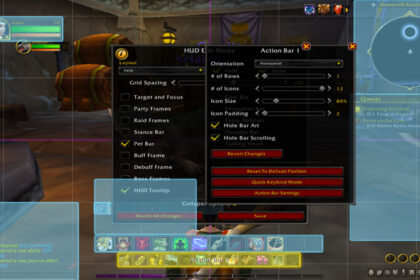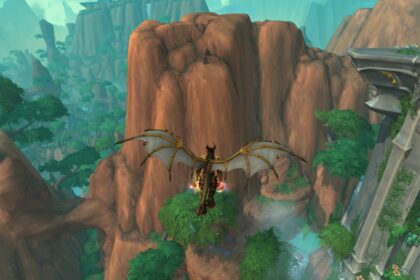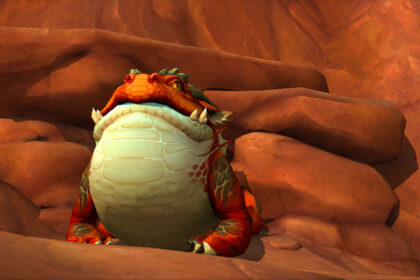Herbalism is one of the most popular professions in World of Warcraft, and Dragonflight introduced a lot of changes and new systems into the world of crafting and gathering. Herbalism is a lot of fun in Dragonflight and it can be lucrative, too.
Leveling up professions can be quite time-consuming, though. To help you max out Herbalism quickly, I’ve put together this guide including my recommendation for a quick route, key items to watch out for, and recommendations for optimizing your Herbalism leveling process in World of Warcraft.
Here’s how to level Herbalism quickly in Dragonflight.
Where to Learn Dragonflight Herbalism
Before you even think about picking a flower or pocketing a herb, you’ll need to make sure that you’ve learnt Dragonflight Herbalism. In previous expansions, it was possible to pick herbs from wherever without learning that specific type of Herbalism. You just wouldn’t gain any levels in Herbalism from it.
That’s changed in World of Warcraft Dragonflight. You’ll need to pick up Dragonflight Herbalism before you do anything else.
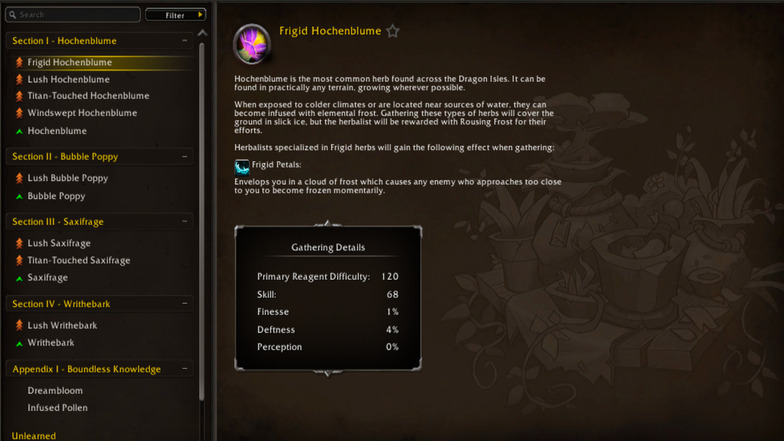
The easiest NPC trainers to get to are in The Waking Shores. Feilin Kuan can be found at the Wingrest Embassy, and Szarostrasza is located in the Ruby Life Pools.
Before you start, it’s worth picking up a reagent bag to keep your materials in and making sure that you’ve got Dragonriding unlocked. The most efficient way to work on leveling Herbalism quickly in Dragonflight is to use Dragonriding.
Leveling Herbalism Quickly
The main four herbs that you can get on the Dragon Isles are Bubble Poppy, Hochenblume, Writhebark, and Saxifrage.
They all grow in different locations (other than Hochenblume, which grows all over the map in every zone) so look for Bubble Poppy near water and damp locations like caves, Writhebark near densely packed trees and bushes, and Saxifrage on either high cliffs and mountains or near volcanoes and plains.
It’s important to note that there are different herbs that you should focus on picking, depending on your Herbalism level.
Hochenblume is a white quality herb, and will only increase your Herbalism level up to 50. The other herbs are all green quality. Bubble Poppy will also only increase your level up to level 50. Saxifrage and Writhebark will go up to level 60 of the Herbalism profession.
Once you’re past level 50-60, you’ll need to focus on finding herbs with different modifiers to continue leveling up Herbalism quickly. The modifiers that herbs can have are:
- Infurious: This modifier can only be seen if you’re playing with War Mode on, and herbs with it can give you Rousing Ire. This material can be traded for PVP gear. The Infurious modifier can also give the Fury of Battle debuff which can reward players with more Rousing Ire when they kill another player.
- Frigid: This modifier causes a sheet of ice to spawn for 12 seconds once the herb is gathered, knocking players down and stunning them for 2 seconds whenever they move. If you have a movement ability like Mage specs do with Blink, you can use this to get out of it. Frigid herbs can also give you Rousing Frost.
- Lush: Lush herbs are simply bigger and better than their regular counterparts. They are visibly larger, and will reward you with more herbs when you gather from them. They don’t have any secondary items to gather.
- Titan-Touched: Titan-Touched herbs are often the easiest to spot but the hardest to get to. They usually grow near tricky mobs or in spots where you might have to fly or teleport to get to. They reward you with Rousing Order when you gather from them. They can also give the buff Enlightened Potential which gives a 15% speed boost.
- Decayed: This zombie herb gives the Coated in Decay debuff which impacts movement, reduces stats, and applies a DoT. You can jump up and down to reduce the impact, or use a purifying spell. The secondary item you can get from Decayed herbs is Rousing Decay.
- Windswept: Windswept herbs give the secondary item Rousing Air. When you gather a Windswept herb, it will send you flying in two different directions. This can be potentially lethal, especially as they’re usually found near cliffs, so make sure you have some sort of fall slowing ability like Priests do.
If you’re someone who’s looking to level Inscription or Alchemy quickly, make sure to keep all of your Rousing secondary items and herbs while leveling Herbalism. While they can fetch a pretty penny on the Auction House, they’re immensely valuable to get your hands on when trying to level up a crafting profession.
The level 60 skill cap on regular herb gathering means you’ll need to switch zones at least once. The most optimal route that I found started by following the river along The Waking Shores until I got to level 50, to quickly find regular herbs that spawned near the water and in the regular grassy areas nearby.
Keep an eye out for herbs on top of hills and cliffs as you go, too.
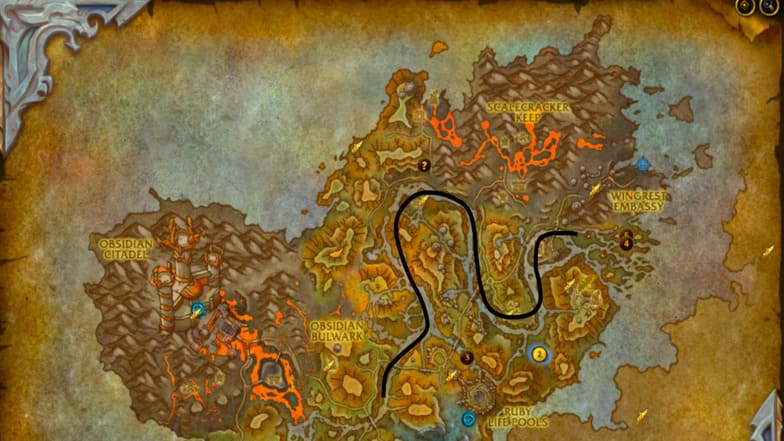
My route then took me to The Azure Span. I went in a loop between the snowy areas and the forested areas, to find a good mix of Frigid herbs and Decayed herbs.

Make sure to keep an eye out for Rich Soil when you’re leveling Herbalism up, as you can plant any Roused Seedlings that you’ve picked up from other herbs there. These won’t increase your level past levels 50-60, but they’re worth doing anyway as it’s a good way to pick up some extra herbs and items.
If you move between The Waking Shores and The Azure Span according to your Herbalism level, you’ll be able to level up quickly and efficiently. It still can take a decent amount of time to get to level 100 in Herbalism, but being mindful of where the herbs grow and the right environments to look in will help a lot.
Picking a Specialization
You’ll need to pick Herbalism specializations as you go, in order to maximize your efficiency and use up the Dragonflight Herbalism Knowledge Points that you gain as you level up your Herbalism skills.
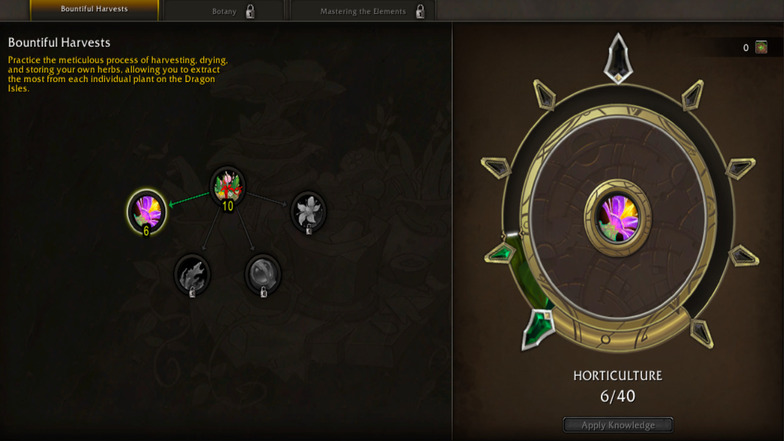
These Herbalism specs are simply subcategories of Herbalism with different focuses, in the same way that Rogue specs all focus on sneaky melee damage but have different attack styles and methods of disposing of enemies.
Unlike class specs, though, there are sub specializations for every profession spec in Dragonflight, meaning you have a lot of choice on how you want to set up your gathering and crafting style.
You can access the spec talent trees and screen in the regular professions tab.
They’re all worth considering, and it really depends on what you want to do with Herbalism. You unlock the ability to pick a specialization at level 25, and you can pick a second and third at levels 50 and 100 too.
The three main specs to pick from are:
- Botany: This Herbalism spec focuses on maximizing your gathering, improving how much you get from each node and boosting the quality of your gathers, too. It also gives useful movement abilities which we’ll look at later. The sub specs, Conservance and Cultivation, focus on improved tools and improved seed usage respectively.
- Bountiful Harvests: This spec focuses on improving your Herbalism skill quickly and it lets you upgrade your herb quality level, too. The sub specs for this specialization are as follows:
- Horticulture: This sub spec focuses on improving your skill, deftness, perception, and finesse when picking Hochenblume.
- Floriculture: This sub spec improves the same stats but for Saxifrage.
- Arboriculture: This sub spec focuses on improving stats for Writhebark.
- Fungiculture: The herb that this spec improves stats for is Bubble Poppy.
- Mastering the Elements: This Herbalism spec focuses on increasing your skill whenever you pick an Elemental herb. It also gives you the ‘Overload Elemental Herb’ ability, allowing you to overload and gather extra herbs and reagents. There are also sub specs based on each individual Elemental herb.
At the time of writing, the Knowledge Points that you put into the talent trees and specializations in professions are permanent and cannot be moved around.
Think about which spec might benefit you the most (are you doing Herbalism to prepare for a raid? to make lots of gold?) and set up your talent tree accordingly.
Choosing the best Herbalism specialization in World of Warcraft will always be slightly tricky as it depends on your personal preferences and aims with Professions, but generally speaking, Botany offers you the most versatility and opportunities to develop your skills and earn plenty of gold while gathering. I’d recommend that spec over the others.
How to Pick Herbs While Mounted
It’s possible to pick herbs while being on your mount in the Dragon Isles, but you’ll need to make some specific choices with your spec decisions if you want to do this.
You will need to earn 40 Knowledge Points and put them all into the Botany specialization tree if you want to be able to gather herbs while being mounted. It’s a particularly useful skill to have, and helps you level up Herbalism much faster.
It’s worth considering your Dragonriding skill tree when optimizing your Herbalism skills, too. I would particularly recommend focusing on skills that help you regenerate Vigor quickly like Yearning for the Sky, as gathering herbs requires a lot of stop and start movement.
What to Do Once You’ve Leveled Herbalism
There’s plenty that you can do after hitting max level with Herbalism in Dragonflight, and the main thing that I’d suggest doing is looking at your secondary profession. Herbalism is often paired with Alchemy or Inscription, as Herbalism materials are useful in both.
If you have leftover materials, make sure to check how much they’re going for on the Auction House and see if you can make some extra gold. Gathering profession materials is a great way to generate a large sum of gold, and it’s worth checking out even if that isn’t one of your main focuses in the game.
If you’re interested in achievement hunting, have a look at your achievement tab and see whether you’ve missed out any Herbalism related achievements. There are quite a few profession achievements and some of them can give you cool rewards.



